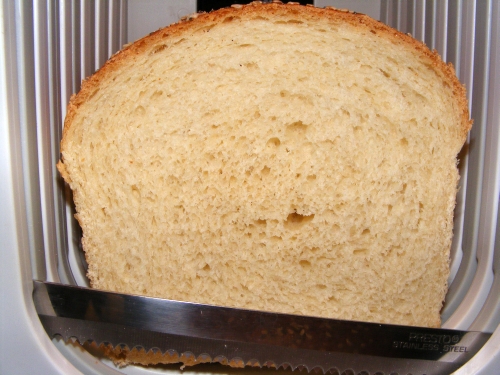
PR's ABED Soft (White) Sandwich Bread and Rolls
This is the 3rd recipe I have baked out of Peter Reinhart's Artisan Bread Every Day. I followed the recipe quite closely, choosing to go with 1 cup of buttermilk and the rest no-fat milk (from instant powdered milk). I used white sugar and canola oil for sweetener and fat. The only real change I made was to add 1 Tablespoon of Hodgson Mills Vital Wheat Gluten (first time I ever used this).
I refrigerated immediately after mixing as suggested and am glad I put it in a larger container cause it way more than doubled overnight. I made one loaf from about 900 grams of dough (9x5 pan) and 3 rolls at 75 gr and 3 rolls at 100 gr. Egg wash and seeds on everything.
Here are some pics.

And here is a close-up.

And an extreme close-up.

And now the crumb. Love my Presto slicer!

Close up.

And one artistic shot (well, it is artistic for an old engineer!)

I will try to remember to update this with some comments on flavor and texture after we eat some. Hopefully it will be soft as decribed by Peter.
Comments always welcome, wayne
TASTE UPDATE (Sat 9/25): We had some of the rolls for lunch today for deli meat sandwiches. Very pleased with texture and taste. Will definately make these again.


Comments
Nicely sliced too!
Sylvia
That recipe is my everyday sandwich loaf. I add another 50g. of water/milk to increase the hydration. That seems to increase loaf volume a bit by increasing gluten without over working it. It gives me an extensible dough without too much elasticity (or, such is my impression), which in turn seems to increase oven spring.
I notice you substituted canola oil* for the butter. Unless you've increased the percentage, to say 15%, you'll have less volume. Canola and olive oils are monounsaturated and do not favor loaf volume as much as polar lipids, e.g. butter or lard. Non-polar lipids, e.g. polyunsaturated oils such as corn or other vegetable oils, can be detrimental to loaf volume.**
That said, the original recipe yields a wonderfully light, soft crumb with good chew. Even toasted, the crumb holds together with a satisfactory chewiness and wonderful taste. This is one of those breads that tastes good all by itself.
cheers,
gary
* Is it true that canola oil is recycled 5W motor oil? :P
** Buehler, E. PhD, Bread Science, and personal correspondence.
Hi Gary,
Thanks for the comments. I didn't think I was substituting since the recipe says:
"6 tablespoons (3 oz / 85 g) vegetable oil or melted unsalted butter"
I usually use oil since I assume it is less bad for me than butter and since a lot of my bread baking is on our boat and away from civilization, oil is easier to store than butter. In fact, I was wondering about either not using an egg or substituting something else for the same reason. Has anyone used powdered eggs in bread? How would they work?
I want to understand your comment regarding butter instead of oil. Are you saying I would get a higher rise with butter. If so, would this come during the final proof or as oven-spring? Also you seem to imply that increasing the oil by about 50% would act more like butter, is that correct?
The directions call for proofing until the dough is 1" above the rim of the pan which doesn't help much if you pan/dough volume is different than he used which was my case.
wayne
I should have paid more attention to the proportions in the recipe. At 10%, the volume boost from fats has about peaked. What happens is that as more pressure from fermentation enlarges the bubbles, the bubble walls break. Oddly, the gas does not escape. There is a lipid film that displaces the protein, and holds the gas. The strongest films are those consisting of polar lipids (saturated fats, e.g. butter, lard, suet). The weakest are non-polar lipids (polyunsaturated fats, e.g. corn and other vegetable oils). Monounsaturated fats fall somewhere in between.
So, no, increasing the amount of oil probably won't make an appreciable difference. Changing to butter probably will-and taste better, too.
cheers,
gary
Wayne, looks like you did some fine baking there!
Ron